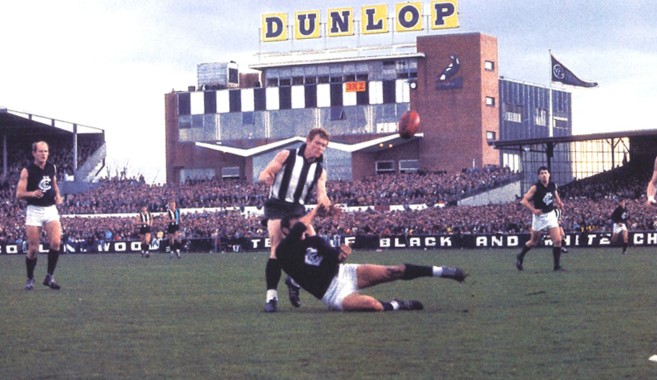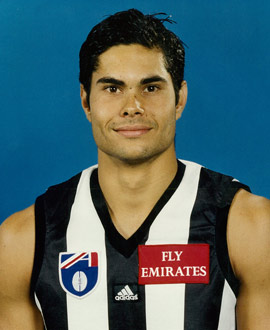By: Glenn McFarlane
The history of guernsey numbers in the 40s makes for a fascinating read.
Nick Maxwell, who played his first 10 games in 2004 in No.43, went on to become a premiership captain. He would switch to No.27 for the next three seasons and was handpicked by the great Nathan Buckley to inherit his No.5.
The man who took the No.43 off Maxwell turned out a pretty handy footballer himself. Heritier Lumumba wore it for two seasons (2005-06), and then took on No.30 for a year before making No.8 his own in recent seasons.
Jarryd Blair wore No.47 in a dozen games in 2010, which included victory in the 2010 Grand Final Replay, before ditching it the following season for No.11. And Sam Dwyer had Langdon's former number - 41 - before taking on the No.2 guernsey this season.
Collingwood has had its fair share of noted footballers wearing jumper numbers in the 40s.
Some of them have held onto the high numbers for their entire careers while others have taken the chance to switch to a lower number at first opportunity. Some have flashed like comets across the Collingwood sky, fading too soon; and others have sunk with little more than a trace.
Sometimes the future of a jumper number in terms of its meaning at a football club can rest on just how the property steward throws the jumper to at a certain time.
That happened midway through the 1984 season when Collingwood’s No.42 happened to land in the arms of a solidly-built, confident young footballer who carried a certain swagger about him and a presence that was immediately recognisable.
The number had worn from 1982 to mid-1984 by Hamilton's Tony Russell, who had played eight games for the club including two in that ’84 season. In one of those early games in 1984, he was one of four players wearing jumper numbers in the 40s, including Mark Beers (40), Jim McAllester (46) and Darren McLaine (45).
But Russell crossed to Preston in the middle of 1984, paving the way for someone else to be handed the No.42.
And as it turned out, the kid with the swagger, who had crossed mid-season from VFA club Dandenong, would take over the jumper.
His name was Darren Millane.
Millane was only five days short of his 19th birthday when he stepped out for the first time in the jumper that he would make famous - in round 18, 1984, against Richmond at Victoria Park.
It wouldn't take him long for him – and his jumper – to become favoured among the faithful.
On and off the field he played the game hard, and he would win the club's best first-year player that season with greater honours in store in the years to come.
Millane would wear the No.42 in 147 games, and most famously, would carry it through the pain of a badly broken thumb in the 1990 finals season, including in the Grand Final, providing an inspiration for that drought-breaking premiership.
He would hold the ball aloft when the final siren ended 32 years of heartache and ridicule.
Millane's final game would come in the last round of the 1991 season. No one knew at the time, but it would be the last time anyone would wear the Black and White No.42 onto the field.
Five weeks later, he would be dead. Millane died in a car accident in October 1991, a year and a day after he played in the premiership side. No Collingwood supporter will ever forget the poignant moment when Millane's No.42 was placed on his coffin, and countless fans wore that number in his honour at one of AFL football's biggest funerals.
Out of respect for Millane’s family, the No.42 has been "retired" ever since.
One of Millane's premiership teammates, Shane Kerrison, was another Collingwood 40-somethings who had played in the 1990 flag. Kerrison wore it with great passion in 141 games from his debut in 1986 to his last game in 1995.
Several other well-known Magpies started out in the 40's before making their careers in other jumper numbers.
Ted Potter played 13 games in No.41 in 1963. Ross 'Twiggy' Dunne had a season in No.48 in 1967 before adopting No.12 for all but the last season of his career in 1978. And guess what, he wore No.44 in his last six games of that season.
Ron Wearmouth also wore No.48 in one game in 1968; while Ricky Barham played out the first three seasons of his career in No.43 before taking on the No.1 jumper. Barham's son, Jaxson, would also make it a father-son 40-something link, wearing his dad's No.43 in seven games in 2009-10.
Leon Davis first appeared in the No.40 jumper in 2000, before taking on the No.1 jumper and transforming into a 200-game Magpie.
Other 40-somethings Magpies have promised plenty with their early performances, but sadly unable to turn it into sustained performances.
One of them was Heath Shephard, who wore No.49, when he kicked five goals and five behinds on debut against Brisbane in 1989. It was a remarkable first-up performance that included 18 disposals and one vote in the Brownlow Medal.
The son of former Magpie Graeme would never reach those heights again, playing a total of 15 games and kicking 17 goals before a short stint with the Brisbane Bears.
For Magpie fans, that story might have sounded familiar when they thought back to Ian McOrist. McOrist only had one touch in his first game as a reserve in 1972, but in his second, he booted six goals against Fitzroy, wearing the No.46.
The former Northcote forward played only one season in Black and White, kicking 16 goals from his 12 games, including one goal in the semi-final loss to St Kilda. He would never play for Collingwood again.
Phillip Walsh looked all set for a big career in Black and White when he won the Best First Year Player after playing every game in a spectacular debut season in 1983. He did it wearing the No.41 jumper. But Magpie fans were left furious when Walsh was swept up in the Richmond-Collingwood poaching wars and signed with the Tigers. He would never again reach the same heights, with Richmond or Brisbane.
Wally Lovett was another Magpie who went to the Tigers during that time. He wore No.46 in 15 games at Collingwood in 1982 before playing 13 games in the next two seasons at Richmond. He is believed to be Collingwood's first indigenous player.
Matthew Ryan was runner-up to Brian Taylor in the 1987 Copeland Trophy and polled nine votes in the Brownlow, in the No.45 jumper. He would play 45 games for the Magpies, kicking 44 goals, before later stints at Sydney and Brisbane.
Mark Fraser also played 45 games for Collingwood. His first two seasons (1992-93) were in the No.47 jumper before he moved to No.7 the following year, and later went to Essendon and onto become an AFL umpire.
Mal Michael would become a triple premiership player with Brisbane, but only after spending four seasons in the No.48 jumper at Collingwood.
And Richard Osborne wore his trademark No.44 at four clubs, most famously with Fitzroy, before stints at Sydney, Footscray and finally Collingwood. He played 29 games and kicked 26 goals for the Magpies in 1997-98.
The 40-somethings might not be reserved to only Tom Langdon, Paul Seedsman and Jack Frost in 2014.
Adam Oxley (No.43) and Caolan Mooney (48) both played senior football last year and could look to keep their numbers as their careers progress.













